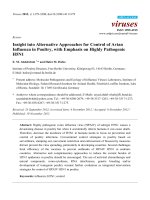- Trang chủ >>
- Đề thi >>
- Đề thi lớp 4
Control of critical coupling in 3x3 MMI couplers based on optical micro-ring resonators and applications to selective wavelength switching, modulation, amplication and oscillation
Bạn đang xem bản rút gọn của tài liệu. Xem và tải ngay bản đầy đủ của tài liệu tại đây (561 KB, 6 trang )
<span class='text_page_counter'>(1)</span><div class='page_container' data-page=1>
<b>CONTROL OF CRITICAL COUPLING IN 3X3 MMI COUPLERS BASED ON </b>
<b>OPTICAL MICRO-RING RESONATORS AND APPLICATIONS TO SELECTIVE </b>
<b>WAVELENGTH SWITCHING, MODULATION, AMPLIFICATION AND </b>
<b>OSCILLATION </b>
<b>Trung-Thanh Le </b>
<i>International School, Vietnam National University, Hanoi (VNU-IS); </i>
<b>Abstract - Micro-ring resonator using 3x3 Multimode Interference </b>
(MMI) couplers or 3x3 planar directional coupler is a promising
component for a new generation of functional optic devices such
as switches, modulators and laser oscillators, which employ
smaller applied voltages for control. In order to achieve these
functional devices, means for voltage control of the coupling
between the waveguides and the resonator is required. This paper
presents a method of controlling the coupling coefficients to meet
the critical coupling of 3x3 micro-ring resonator applied to optical
switching, modulation and oscillation.
<b>Key words - Integrated optics; Coupled resonators; Multimode </b>
Interference Couplers
<b>1. Introduction </b>
Micro-ring resonator is a promising device for
applications in the field of optical communications. Using
this structure, basic signal processing functions such as
wavelength filtering, routing, switching, modulation, and
multiplexing can be achieved [1]. However, most racetrack
resonators have been designed and fabricated using
directional couplers or 2x2 MMI couplers as a coupling
element between the ring and the bus waveguides. Recently,
we have been proposed a novel configuration of a micro-ring
resonator using 3x3 MMI couplers [2, 3]. Devices using this
structure hold the promise of a new generation of light
switching, amplification, laser oscillation, and modulation.
Before this can proceed to real applications, we need to
find out the mechanism to control the coupling coefficients
precisely. One of the most interesting features is that the
resonators operate at resonance wavelength and thus critical
coupling can be achieved. This is the purpose of the present
paper, in which we propose a configuration for precisely
controlling the coupling coefficients of the coupler by using
electro-optic or thermo-optic effect. The analysis of the
device is based on self-imaging theory and transfer matrix
method. Performance parameters are discussed.
From the research by A. Yariv about the modelling of
micro-ring resonator based on 2x2 directional coupler as a
matrix, this model is particularly important and used
widely in analysis of optical circuits based on 2x2
micro-ring resonators [4, 5]. This research is to present an analysis
and modelling of micro-ring resonators based on 3x3 MMI
(multimode interference) and 3x3 planar directional
coupler. Both structures are suitable for integrated optical
circuits and a versatile functional device can be created
from these structures.
In the literature, 3x3 fiber based resonators have been
proposed and some applications based on this structure
have been presented [6-10]. However, such analysis is not
applicable to general applications. Here, we present an
universal analysis applied for both 3x3 MMI and 3x3
planar directional coupler based micro-ring resonators.
<b>2. Theory </b>
A micro-ring resonator based on a 3x3 coupler is
proposed in Fig. 1 below. It consists of lossless coupling
between two optical waveguides and a ring resonator. The
3x3 coupler in this paper is made from a 3x3 MMI coupler.
Compared to 3x3 fibre couplers or planar couplers, 3x3
MMI couplers have the advantage of the relaxed fabrication
tolerances and the ease of integration of these devices into
more complex photonic integrated circuits, small size, and
low excess loss. Therefore, the use of 3x3 MMI couplers in
micro-ring resonator configurations not only takes these
advantages, but also precisely designs the desired couplers.
<i><b>Figure 1. Geometry of micro-ring resonator using a 3x3 coupler </b></i>
As given in [5], by controlling the coupling coefficients
of the coupler to meet the critical coupling, small changes
in the internal loss for a given coupling coefficient, or vice
versa, can control the transmitted power, between unity and
zero. Therefore, switching and modulation functions can
be realized from this characteristic if we know how to
control these parameters. Moreover, if we include a gain
(optical amplifier) inside the ring resonator, the transmitted
power can reach infinite value if the relation between the
internal loss and coupling coefficient meet certain
particular conditions.
</div>
<span class='text_page_counter'>(2)</span><div class='page_container' data-page=2>
generalized Mach–Zehnder interferometer (MZI)
sandwiched between two 3x3 MMI couplers into the ring
resonator. The MZI introduces the phase shifts
<i><sub>i</sub></i> (i=1-3)in its three arms.
Using the self-imaging theory, the 3x3 MMI coupler
can be described by a transfer matrix [11]
j( 11 / 24) j( 13 / 24) j( 5 / 24)
j( 13 / 24) j( 5 / 24) j( 13 / 24)
j( 5 / 24) j( 13 / 24) j( 11 / 24)
1 1 1
e e e
3 3 3
1 1 1
M e e e
3 3 3
1 1 1
e e e
3 3 3
(1)
where is a constant phase, <sub>0</sub>L<sub>MMI</sub> 9
24
, <sub>0</sub> is the
constant propagation of the fundamental mode within the
MMI region, and
L
<sub>MMI</sub> is the length of the MMI coupler,MMI
L L
2
r
4n W
3 ;
n
r, W, are refractive index ofthe core, width of the MMI coupler, and optical waveguide
respectively; L is the beat length of the two lowest order
modes in the MMI region.
The field c (<sub>i</sub> i 1 3 ) at the output of the MMI coupler
can therefore be related to the input field a<sub>i</sub>(i 1 3 ) by
the following matrix equations
1 1
2 2
3 3
c a
c M a
c a
<sub></sub>
, and
1 1
2 2
3 3
b d
b M d
b d
<sub></sub>
(2)
The overall transfer matrix S of the MMI-GMZ structure
shown in Fig. 2 is found from the product of the transfer
matrices of the MMI splitter, the phase shifters, and the MMI
combiner, and can therefore be written as [12]
SMM (3)
where M is the transfer matrix for each MMI coupler and
is the matrix due to the phase shifters
j1 j 2 j3
diag e,e ,e
(4)
Using (1) and (2) in (3) lead to the transmission
expressions at the output port 1,
1
b
P
and port 2,2
b
P
respectively
1
2
j j
13 31 13 32
b 11 j 1 12 j 2
33 33
s s e s s e
P s )a (s )a
1 s e 1 s e
(5)
2
2
j j
23 31 23 32
b 21 j 1 22 j 2
33 33
s s e s s e
P (s )a (s )a
1 s e 1 s e
(6)
Therefore, we obtain the transmitted powers at output
ports when the input signal entering from port 1only
(
a
<sub>2</sub>
0
) is as follows
2
j
13 31
1 11 <sub>j</sub>
33
s s e
P (s )
1 s e
(7)
2
j
23 31
2 21 j
33
s s e
P (s )
1 s e
(8)
And the transmitted powers at output ports when the
input signal entering from port 2 (
a
1
0
) are2
j
13 32
3 12 <sub>j</sub>
33
s s e
P s
1 s e
(9)
2
j
23 32
4 22 j
33
s s e
P s
1 s e
(10)
Without loss of generality, it is assumed that the optical
waveguides support only one mode-the fundamental one and
that the coupling is lossless, the relationship between output
complex amplitudes and input complex amplitudes of the
device can be described by using a coupling matrix as follows
1 11 12 13 1 1
2 21 22 23 2 2
3 31 32 33 3 3
b a a
b a M a
b a a
<sub> </sub> <sub></sub> <sub></sub> <sub></sub>
<sub></sub> <sub></sub> <sub></sub>
(1)
3 3
a exp( j )b (2)
Where
<sub>ij</sub>,
<sub>ij</sub>( i, j 1 3 ) are transmission and coupling<i>coefficients of power from input ports i to output ports j;</i>
0
exp( L)
is the transmission loss inside the resonators,
and <sub>0</sub> (dB/cm) is the loss coefficient in the core of the
optical waveguides. is the phase accumulated over L
the ring waveguides with propagation constants , where
eff
2 n /
, n<sub>eff</sub> and are effective refractive index of
the waveguide core and optical wavelength, respectively.
The conservation of energy principle results in the
equivalent conditions: M M and * MM are unit matrices. *
Therefore, we have the following equations
2
2 2
11 21 31 1
(3)
2
2 2
12 22 32 1
(4)
2 2 2
13 23 33 1
(5)
The field amplitudes are normalised to the input
amplitudes
a
<sub>1</sub> (ora
<sub>2</sub>), that means we can choosea
<sub>1</sub>
1
(or
a
<sub>2</sub>
1
). The transmission around the ring is thencalculated by
j j
13 31 13 32
1 11 j 1 12 j 2
33 33
e e
b ( )a ( )a
1 e 1 e
(6)
j j
23 31 23 32
2 21 j 1 22 j 2
33 33
e e
b ( )a ( )a
1 e 1 e
</div>
<span class='text_page_counter'>(3)</span><div class='page_container' data-page=3>
From (6) and (7), we obtain the transmitted powers at
output ports when the input signal entering from port 1(
2
a
0
)is as follows2
j
13 31
1 11 <sub>j</sub>
33
e
P ( )
1 e
(8)
2
j
23 31
2 21 <sub>j</sub>
33
e
P ( )
1 e
(9)
And the transmitted powers at output ports when the
input signal entering from port 2(
a
<sub>1</sub>
0
) are2
j
13 32
3 12 <sub>j</sub>
33
e
P
1 e
(10)
2
j
23 32
4 22 <sub>j</sub>
33
e
P
1 e
(11)
As an example, we consider the former case in this
paper. (8) and (9) can be rewritten in the following forms:
13 31 11 33
11
33
2
j( ) j( )
j j
11 13 31 33 11
1 j( )
33
e ( e e ) e
P
1 e
(12)
23 31 21 33
21
33
2
j( ) j( )
j j
21 13 23 33 21
2 j( )
33
e ( e e ) e
P
1 e
(13)
Here
<sub>ij</sub>( i, j 1 3 ) are the phases of couplingcoefficients. Most of the interesting features of this
resonator occur near resonance , where m 33 2 m
is integer. At resonance the transmitted powers at output
ports 1 and 2 only depend on the loss inside micro-ring
resonator and coupling coefficients.
13 31 33
11 11
2
j( )
j j
11 13 31 33 11
1
33
e ( e e )
P
1
(14)
23 31 33
21 21
2
j( )
j j
21 13 23 33 21
2
33
e ( e e )
P
1
(15)
One of the most special characteristics is that when a special
relation between the internal loss and coupling coefficients is
achieved, the power at output port 1 or output port 2 will vanish
<i>and this condition is called critical coupling condition as </i>
well-known in the microwave field [13]. The useful characteristics
of the device such as switching, modulation and laser oscillation
can be obtained from this condition.
<b>3. Simulation results and discussions </b>
As an example, we consider a ring resonator based on
a 3x3 planar waveguide coupler only. The configuration
of the ring resonator using a 3x3 coupler is shown in
Figure 3.
<i><b>Figure 3. Micro-ring resonator using a 3x3 planar coupler </b></i>
It is noted that our general theory can be applied to
micro-ring resonator based on any kind of 3x3 couplers
formed from 3x3 planar optical waveguides or 3x3
multimode interference (MMI) couplers. A 3x3 planar
optical waveguide coupler is analyzed by the coupled mode
theory and the other can be analyzed by using the
self-imaging theory [14].
As an example, 3x3 planar directional coupler and 3x3
MMI coupler have been investigated in Figure 4 and 5. The
silicon waveguide is used for the simulations. The
waveguide has a standard silicon thickness of
co
h 220nm and access waveguide widths are
a
W 0.5 m for single mode operation. It is assumed that
the designs are for the TE polarization at a central optical
wavelength 1550nm.
(a) Gap between two adjacent waveguide g=100nm
(b) Gap between two adjacent waveguide g=300nm
</div>
<span class='text_page_counter'>(4)</span><div class='page_container' data-page=4>
The coupler consists of three optical waveguides with
their centers aligned in the same plane. It is assumed that
the coupling exists only between the neighboring pairs of
waveguides. The coupling characteristics can be obtained
by using the mode coupling theory. Complex amplitudes
<i>i</i>
<i>a</i>
of the fields inside three waveguides are governed by aset of differential equations [7]
1
12 1
1
21 23 2
32 3
1
da
dz <sub>0</sub> <sub>j</sub> <sub>0</sub> <sub>a</sub>
da
j 0 j a
dz
0 j 0 a
da
dz
<sub> </sub> <sub></sub>
<sub></sub> <sub> </sub>
(16)
Solving (16) with
<sub>ij</sub> ( i, j 1 3 ) being coupling<i>coefficients between the waveguide i and j, the output field </i>
amplitudes of the 3x3 coupler are given by
1 1
2 2
3 3
1 1
j j
2 2
b a
1 1 1
b j ( 1) ( 1) a
2 2
2
b a
1 1 1
j ( 1) ( 1)
2 2
2
<sub></sub> <sub></sub> <sub> </sub> <sub></sub>
<sub></sub> <sub></sub>
<sub> </sub> <sub></sub> <sub> </sub> <sub> </sub>
<sub></sub> <sub></sub>
(17)
where
cos( 2kz)
, and
sin( 2kz)
aretransmission and coupling coefficients, k2
is the wave
number, z is the coupling length.
Substituting (17) into (8), (9) and (10), (11), the
transmitted power at the output port in the two cases can be
expressed by
<i>Input port </i>a<sub>1</sub><i> (normalized) </i>1
2 2 2
1 <sub>2</sub> <sub>2</sub>
1 (1 ) 4 4 (1 ) cos( )
P
4 1 0.25 (1 ) (1 ) cos( )
(18)
2 2
2 <sub>2</sub> <sub>2</sub>
1 (1 )[1 2 cos( )]
P
2 1 0.25 (1 ) (1 ) cos( )
(19)
<i>Input port </i>a<sub>2</sub> <i> (normalized) </i>1
2 2
3 <sub>2</sub> <sub>2</sub>
1 (1 )[1 2 cos( )]
P
2 1 0.25 (1 ) (1 ) cos( )
(20)
2 2 2
4 <sub>2</sub> <sub>2</sub>
1 (1 ) 4 4 (1 ) cos( )
P
4 1 0.25 (1 ) (1 ) cos( )
(21)
and the power at output port 3:
2
5 2 2
1
P
2(1 0.5 (1 ) (1 ) cos( ))
(22)
At resonance, , where m is some integer, the 2 m
above equations are rewritten as follows
2
1 <sub>2</sub>
1 [(1 ) 2 ]
P
4 [1 0.5 (1 )]
(23)
2 2
2 <sub>2</sub>
1 (1 )(1 )
P
2 [1 0.5 (1 )]
(24)
2 2
3 <sub>2</sub>
1 (1 )(1 )
P
2 [1 0.5 (1 )]
(25)
2
4 <sub>2</sub>
1 [ (1 ) 2 ]
P
4 [1 0.5 (1 )]
(26)
It should be noted that P<sub>2</sub>P<sub>3</sub> and its value will vanish
only when 1<sub> or </sub> 1<sub>(lossless case, i.e. there is no </sub>
optical loss inside the ring resonator). Therefore, these
ports will not be used in our analysis.
From (26), it shows that for the case input signal at port
2, the transmitted power at output port 2 vanishes, i.e.
4
P , when the relation between the coupling coefficient 0
and the internal loss meets the condition:
2
.
This is also the critical condition of the resonator.
<i><b>Figure 5. Simulations of a 3x3 MMI cascaded coupler </b></i>
Figure 6 shows the power transmission characteristics
3
P against the internal loss for a given value of the
<i>coupling length kz. The dependence of the transmission on </i>
</div>
<span class='text_page_counter'>(5)</span><div class='page_container' data-page=5>
<i><b>Figure 6. Transmitted power at the output port 2, </b></i>
𝑃3<i>against the internal loss∝ at a variety of the coupling lengths </i>
<i>kz=0.05, 0.10, and 0.13 </i>
Figure 7 shows the transmission characteristics against
<i>frequency near critical coupling for a given value kz=0.13 </i>
( 0.9958). The device is designed on Silicon on
Insulator (SOI) technology. Optical waveguides supports
only one mode with the effective refractive index
eff
n 3.4767calculated from the Finite Difference
Method (FDM)[15]. Ring resonator has a radius
R300 m large enough to reduce the bending loss. The
simulations are carried out for four different values of the
internal loss 0.99<i>, 1.0, 1.005, and 1.0085. A gain is </i>
concluded in the ring resonator to have . In this case, 1
the transmitted power is amplified. An important
characteristic of this resonator is that the resonance peak
can be made arbitrarily narrow. When 2 / (1 , )
according to (25), the transmission reaches infinite value.
This means that laser oscillation is obtained.
<i><b>Figure 7. Transmitted power at the output port 2 ,</b></i>P<sub>3</sub><i> against </i>
<i>wavelength at different value of the internal loss ∝= 0.99, 1.0, </i>
<i>1.005, and </i>1.0085<i>. The figure shows the transmission near a </i>
<i>resonance wavelength λ 1545.223nm</i>
Some performance parameters of the resonator are
Finesse, Q-factor, resonance width, and bandwidth. These
are all terms that are mainly related to the full width at half
of the maximum (FWHM) of the transmission. The
FWHM of the micro-ring resonance is the resonance width
or the bandwidth and can be calculated from (27) below.
max
5 <sub>2</sub>
T
P
1 Fsin ( / 2)
(27)
2
FWHM
eff
[ (1 ) 2]
n L 2 (1 )
(28)
where
2
max <sub>2</sub>
2(1 )
T
[ (1 ) 2]
, 2
8 (1 )
F
[ (1 ) 2]
, and L is
the circumference of the ring.
The Free Spectral Range (FSR) is the distance between
two peaks on a wavelength scale. By differentiating the
equation L, we get
2
g
FSR
n L
, where the group
index is n<sub>g</sub> n<sub>eff</sub> dneff
d
.
The Finesse F is defined as the ratio of the FSR and the
bandwidth and thus can be calculated by
FWHM
FSR
F
.
Moreover, The Q-factor is defined as the ratio of the
wavelength of the peak to the FWHM of the peak,
FWHM
Q
.
For the case input signal at port 1, the power at output
port 1 is calculated from (23). The power P vanishes only <sub>1</sub>
if <sub>1</sub> 1 / (2 and the power 1) P reaches infinite <sub>1</sub>
value with <sub>2</sub> (2 . This may be one of the most ) /
interesting characteristics of the ring resonator because for a
given value of the internal loss or gain , the difference
between the values of and <sub>1</sub> is very small. Therefore, a <sub>2</sub>
very low power switch can be made from this configuration
by using thermo-optic, or electro-optic effects.
<b>4. Conclusion </b>
We have presented a universal analysis for micro-ring
resonators using 3x3 couplers. Expressions for the output
intensities for the ring resonator based on any kind of 3x3
couplers are derived. The transmission characteristics of a
ring resonator designed on SOI technology as well as the
performance parameters including the free spectral range,
finesse, and Q-factor are studied. The switching,
modulation and laser oscillation functions have been
realized. It shows that these resonators will be very
promising passive and active components for photonic
integrated circuits in the future.
<b>Acknowledgements </b>
</div>
<span class='text_page_counter'>(6)</span><div class='page_container' data-page=6>
<b>REFERENCES </b>
[1] Ioannis Chremmos, Otto Schwelb, and Nikolaos Uzunoglu
<i>(Editors), Photonic Microresonator Research and Applications: </i>
<b>Springer, 2010. </b>
[2] Trung-Thanh Le, "Microring resonator Based on 3x3 General
Multimode Interference Structures Using Silicon Waveguides for
Highly Sensitive Sensing and Optical Communication
<i>Applications," International Journal of Applied Science and </i>
<i><b>Engineering, vol. 11, pp. 31-39, 2013. </b></i>
[3] T. T Le and L. W Cahill, "Microresonators Based on 3x3 Multimode
<i>Interference Couplers on an SOI Platform," in The 2009 Annual </i>
<i>Meeting of the IEEE Lasers & Electro-optics Society (LEOS), </i>
<b>Belek-Antalya, Turkey, 4-8 Oct. 2009. </b>
[4] J. M. Choi, R. K. Lee, and A. Yariv, "Control of critical coupling in
a ring resonator–fiber configuration: application to
wavelength-selective switching, modulation, amplification, and oscillation,"
<i><b>Optic Letters, vol. 26, pp. 1236-1238, 2001. </b></i>
[5] A. Yariv, "Critical coupling and its control in optical
<i>waveguide-ring resonator systems," IEEE Photonics Technology Letters, vol. </i>
<b>14, pp. 483-485, 2002. </b>
[6] S.K. Sheem, "Optical Fiber Interferometers with 3x3 Directional
<i>Couplers: Analysis," Journal of Applied Physics, vol. 52, pp. </i>
<b>3865-3872, June 1981. </b>
[7] Y. H. Chew, Tjeng T. Tjhung, and F. V. C Mendis, "Performance
of single-and double-ring resonators using 3 x 3 optical fiber
<i>coupler," Journal of Lightwave Technology, vol. 11, pp. </i>
<b>1998-2008, 1993. </b>
[8] Xiaobei Zhang, Dexiu Huang, and Xinliang Zhang, "Transmission
characteristics of dual microring resonators coupled via 3×3
<i><b>couplers," Optics Express, vol. 15, pp. 13557-13573, 2007. </b></i>
[9] Chao Ying Zhao and Wei Han Tan, "Transmission performance of one
waveguide and double micro-ring resonator using 3×3 optical fiber
<i><b>coupler," Journal of Modern Optics, vol. 63, pp. 1726-1733, 2016. </b></i>
[10] Xiaobei Zhang, Dexiu Huang, and Xinliang Zhang, "Transmission
characteristics of dual microring resonators coupled via 3x3
<i><b>couplers," Optics Express, vol. 17, pp. 13557-73, 2007. </b></i>
[11] Trung-Thanh Le, " Arbitrary Power Splitting Couplers Based on 3x3
<i>Multimode Interference Structures for All-optical Computing," </i>
<i>International Journal of Engineering and Technology, Singapore, </i>
<b>vol. 3, pp. 565-569, 2011. </b>
[12] Trung-Thanh Le, "Arbitrary Power Splitting Couplers Based on 3x3
Multimode Interference Structures for All-optical Computing,"
<i>International Journal of Engineering and Technology, Singapore, </i>
<b>vol. 2, pp. 565-569, 2011. </b>
[13] A. Yariv, "Universal relations for coupling of optical power between
<i>microresonators and dielectric waveguides," Electronics Letters, </i>
<b>vol. 36, pp. 321–322, 2000. </b>
[14] M. Bachmann, P. A. Besse, and H. Melchior, "General self-imaging
properties in N x N multimode interference couplers including phase
<i><b>relations," Applied Optics, vol. 33, pp. 3905-, 1994. </b></i>
<i>[15] Lê Trung Thành, Nguyen Canh Minh, Nguyen Van Khoi et al., </i>
"Design of silicon wires based directional couplers for microring
<i>resonators," Journal of Science and Technology, University of </i>
<i>Danang, vol. 11, 2015.</i>
</div>
<!--links-->









